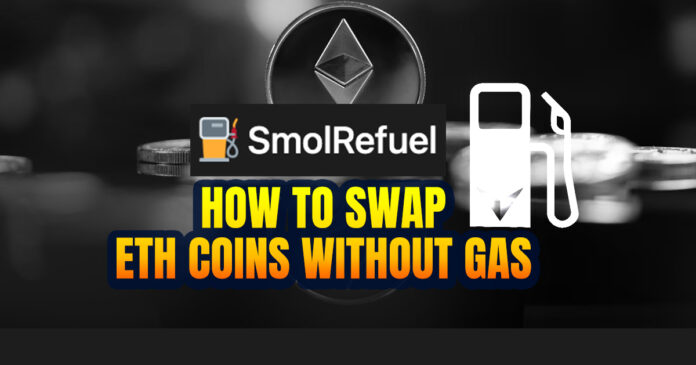Every day, the Ethereum network sees over a million transactions, showcasing its substantial utility beyond mere price speculation. As the primary hub for on-chain activities within the crypto sphere, Ethereum is synonymous with DeFi, attracting considerable traffic that often leads to network congestion and elevated transaction fees. While increased activity is favorable, the fee surge renders the chain economically impractical for many users.
Expectations were high among Ethereum users following the Merge, anticipating a reduction in gas fees. However, recent developments show that substantial transaction fees remain a prevalent concern. Let’s take a look at the Ethereum gas fee scene and a new dApp, SmolRefuel.
Has Exorbitant ETH Gas Fees Become A Norm?
Since the start of February, Ethereum’s transaction volume has risen, coinciding with network gas fees reaching a multi-month peak. On February 9, Ethereum’s network gas prices hit an average peak of 70 gwei ($60 for a standard transaction), with peak gas costs soaring to as high as 377 gwei, unseen since May 12, 2023.
.7 in GAS, ETH is fucking DEAD man.
NO Web 2 company is going to come in and use this chain.
They won't risk offering a terrible customer experience, where customers are uncertain what they'll be paying, and every customer paying different fees.
They won't tolerate this.… pic.twitter.com/zVriwn57mt
— Zimmy (@Zimmy_eth) February 22, 2024
The recent uptick in gas prices can be due to various factors. Over the past week, NFT trading on Ethereum has surged to its highest levels since late February of the previous year. Moreover, it coincided with increased attention on the ERC-404 token standard across the crypto industry. ERC-404 aims to link ERC-721NFTs with ERC-20 tokens, enabling fractionalized NFTs, where multiple wallets can each own a portion of a single NFT, facilitating trading or staking for loans.
Despite expectations of reduced gas fees post-merge, exorbitant fees remain a concern, putting a strain on users due to the substantial amounts they have to pay.
Why A Network Charge Transaction Fee?
Transaction fees are a fundamental aspect of nearly every blockchain, required to finalize any transaction within its network. These fees vary across blockchains, with Ethereum recognized for its robust security but also notorious for its high gas fees.
In simple terms, Ethereum gas fees refer to the charges incurred for processing transactions or executing contracts on the Ethereum blockchain. Typically, these fees depend on the transaction’s complexity and the network congestion level. Users pay these fees in ETH, incentivizing miners to include their transactions in a block.
Gas fees depend on two primary factors: gas price and gas limit. Gas price represents the amount of ETH users are willing to pay for each unit of gas, measured in gwei (where 1 gwei equals 0.000000001 ETH). The gas limit denotes the maximum amount users are willing to allocate for a transaction, measured in gas units. The blockchain then calculates the total gas fee as the product of the gas price (composed of the base fee and priority fee) and gas limit.
Gas fees can vary based on the platform’s intended use and supply-demand dynamics. During the 2017-2018 bull market, average gas fees were approximately $5-6. Since then, fees have steadily risen, with increased Ethereum prices and network congestion as major contributing factors.
What Is Network Congestion?
Network congestion occurs when many individuals attempt to execute transactions simultaneously, akin to traffic congestion on a busy road. The fact that users can increase their gas fees to enhance the likelihood of their transactions being confirmed by validators compounds this issue.
Consequently, this situation triggers bidding wars, where users vie to offer the highest possible gas fee to facilitate transfers or smart contracts. As demand escalates, so do the gas fees required for a transaction to gain priority with validators and avoid failure.
In these bidding wars, the effects of network congestion get exacerbated. Although no immediate solution exists to mitigate these effects, the outcome is predictable: users lacking sufficient capital to sustain economically viable transactions on the Ethereum network gradually withdraw from its usage.
Applying the Pareto principle to this scenario suggests that most network participants refrain from executing transactions during periods of intense congestion, leading to a subsequent drop in gas fees, often as rapidly as they surged. The economic incentives inherent in this system typically result in short-lived episodes of network congestion.
However, the unpredictable nature of financial markets, driven by the irrational behavior of investors, precludes precise predictions regarding the ceiling of gas fees during congestion spikes.
The relentless upward trajectory of gas prices, should millions of new investors flock to Ethereum, stresses the critical importance of developing scalability solutions over the long term.
Scalability Solutions or Scaling Ethereum?
Many once heralded Ethereum as the future of transactions, yet recent challenges, as we discussed, have prompted a shift towards layer 2 solutions like Polygon and Arbitrum. These alternatives offer significantly lower fees than the Ethereum main chain while maintaining comparable security levels.
The advancement of L2 tech has been remarkable since 2021, partly catalyzed by Ethereum’s transition to a proof-of-stake model and resulting in substantially reduced costs on these side chains. However, utilizing an L2 chain still presents challenges, with the experience often cumbersome and complex, particularly for non-technical users.
So, addressing the high gas fee issue is imperative for Ethereum’s longevity—failure to do so risks further migration to more efficient Layer 1 solutions.
Is Ethereum Working On A Solution?
Since its inception, Ethereum has operated on a Proof of Work (PoW) consensus algorithm to validate transactions and integrate them into its network. However, in September 2022, Ethereum underwent a significant transformation as its mainnet merged with the Beacon chain, a momentous event known as The Merge. This transition marked Ethereum’s shift from the PoW consensus mechanism to Proof of Stake (PoS).
Contrary to common assumptions, The Merge itself wasn’t specifically aimed at reducing gas prices, which is why its impact on the gas fees paid by Ethereum users has been minimal thus far.
Nevertheless, Ethereum’s move to PoS was pivotal for implementing sharding, a mechanism involving deploying multiple side chains to alleviate the burden on the mainnet. Enhanced scalability resulting from sharding promises significantly reduced network congestion.
Theoretically, this means the network can process transactions smoothly, even during high transaction volumes.
Unfortunately, despite recent milestones like The Merge and the successful Shanghai upgrade, Ethereum still grapples with scalability challenges.
However, the upcoming Dencum upgrade, anticipated in the first quarter of 2024, holds considerable promise for addressing Ethereum’s persistent issues, including scalability, security, and efficiency. This upgrade will introduce nine Ethereum Improvement Proposals (EIPs), notably EIP-4844, which aims to alleviate gas fees by introducing new transactions carrying “blobs.” These blob-carrying transactions are expected to cost less due to their larger sizes, offering relief from high gas fees.
While implementing these upgrades is eagerly awaited, their effectiveness in addressing the network’s shortcomings remains to be seen.
SmolRefuel
Currently, users find themselves obliged to pay these exorbitant gas fees. But what if someone wants to sell ERC-20 tokens without possessing any ETH?
0xngmi from DefiLlama has addressed this dilemma by creating a dApp: SmolRefuel. This platform facilitates swaps without requiring initial ETH.
Now, what exactly is a Permit?
Introduced in the ERC20 protocol via EIP-2612, the Permit allows users to interact with smart contracts without prior authorization by attaching an authorization signature.
In ERC20 token transactions, it’s customary for account A to use the approve function to grant authorization to account B, enabling B to manage specific tokens owned by A.
However, the permit function operates differently. It empowers account A to generate an off-chain authorization signature for the designated recipient, which account B can utilize to execute the permit function and conduct authorized operations on behalf of A. Notably, the permit function can be executed by any account, irrespective of ownership.
Ever had tokens but no gas money to use them?
I built https://t.co/ti7MmPuyTc to solve this, it uses permits to do a swap that requires no initial ETH, so you can get your first ETH pic.twitter.com/gQNcCxUudn
— 0xngmi (@0xngmi) February 4, 2024
Anyhow, Smolrefuel is compatible with most ERC20 tokens supporting Permit, boasting support for over 81 chains, including prominent L1 chains like BNB Chain, Harmony, and more. Essentially, while interacting with the platform, users sign a permit, which is then submitted by a bot to initiate transactions, execute swaps, and send ETH to the user.
The platform’s smart contract ensures full expenditure of permit approval, leaving no residual authorization. Additionally, the signature expires after one hour if a transaction fails or reverts. Moreover, for more safety, the platform restricts swaps to values less than $1k.
As the platform is still in development, users must exercise extreme caution when using it.
Conclusion
Gas fees on Ethereum are essential for ensuring the platform’s proper operation. Complex transactions naturally incur higher fees compared to simpler ones. However, there are instances where the fees charged may not align with the transaction’s value.
Ethereum should, instead of solely depending on various L2 solutions, prioritize resolving the issues of high gas fees and scalability.
Meanwhile, innovative solutions like SmolRefuel offer promising enhancements to the ETH Gas infrastructure, presenting opportunities for improvement within the ecosystem.
Stay tuned for more!
Disclaimer
The information discussed by Altcoin Buzz is not financial advice. This is for educational, entertainment, and informational purposes only. Any information or strategies are thoughts and opinions relevant to the accepted levels of risk tolerance of the writer/reviewers and their risk tolerance may be different than yours. We are not responsible for any losses that you may incur as a result of any investments directly or indirectly related to the information provided. Bitcoin and other cryptocurrencies are high-risk investments so please do your due diligence. Copyright Altcoin Buzz Pte Ltd.





























